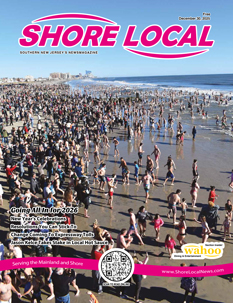By William Kelly
“Who was the Shore Road Sea Captain?” was the question that came in. And while there were probably a number of them over the years and decades, I could only think of one who stands out.
Commander Richard Somers, who was born on the corner of Shore and Bethel roads where there is now an historical memorial to mark the spot, and whose father was a colonel in the Revolutionary War militia, is the one who comes to mind for me.
Most famous as the “father of U.S. Navy,” Commander Richard Somers was killed during the war against the Barbary Pirates in Tripoli, Libya, in 1804, and remains buried there with his shipmates “on the shores of Tripoli.” He is the subject of one of the historic plays currently being produced at the Gateway Playhouse on Bay Avenue in Somers Point.
The heroics of the Richard Somers name span generations.
Colonel Richard Somers, father of the Tripoli hero, was the captain of a schooner – a sleek and fast two-masted sailing ship commonly made in the area, and used as merchant ships or for fishing.
Richard lived in his home/tavern on the corner of Shore and Bethel Road, which existed into the 1970s, when it was renovated into an office complex, despite attempts to save it for its historic significance. The original Bethel Chapel, just down the road, was known as the Sea Captain’s Church and Richard Somers’ home/tavern was popular with locals and transients passing through.
With the signing of the Declaration of Independence and the establishment of a colonial government, Colonel Somers was one of the sea captains who was given a commission as a privateer, legally tasked with capturing British merchant ships, which were taken to Port Republic, just north of Smithville on the Little Egg Harbor River, now the Mullica. There the captured contents were advertised for sale at auction in Philadelphia and New York newspapers, which infuriated the British.
Upstream from Port Republic was Batsto, which remains preserved as an historic colonial village where munitions – cannonballs and musket shot – were made. There the bog iron was melted in a furnace, measured and dropped from the top of a tower. As it fell it rolled into balls that solidified when they hit the cold creek waters to create balls. The ammo was ultimately delivered to Washington’s army at Valley Forge.
During the Revolution, because of his stature in the community, Richard Somers was commissioned as a colonel in the local militia.
His son Richard, who would become Somers Point’s most renowned naval hero, was born at home in September 1778, during the Revolution. A month later, in October 1778, Colonel Somers took his musket from the fireplace mantle, saddled his horse and led his militia to Port Republic, the destination of a British flotilla. The goal of the British was to destroy the town of Chestnut Neck, then go upstream to capture Batsto and put an end to the privateering and ammo supply.
The best account of the Battle of Chestnut Neck at Port Republic is the book, “Nest of Rebel Pirates,” which is what the British called Port Republic at the time. It was written by Linwood historian Franklin Kemp and is available online at batstovillage.org.
The Patriots had been notified in advance that the British fleet was on its way. Bad weather delayed its arrival so the privateers escaped in their ships and removed what they wanted. But the British troops recaptured and scuttled 10 vessels and burned most of the village of Chestnut Neck, now known as Port Republic. Two of the large British ships ran aground in the shallow waters and were kept from reaching Batsto.
Fired upon and harrassed by the colonial militia including Colonel Somers’ contingent, and forewarned that American reinforcements led by Count Casimir Pulaski, the British retreated.
A contingent of about 50 of Pulaski’s men made it to what is now Mystic Island, where a larger group of Americans loyal to the crown, led by Captain Ferguson, ambushed them in their sleep. It became known as the Little Egg Harbor Massacre.
In his book, Kemp notes that one of the British Redcoats who was ordered to burn the village at Chestnut Neck was smitten by a local girl and spared her home, later returning to marry her.
Kemp also told friends and associates that he was writing a biography of Colonel Somers’ son Richard, and had corresponded with some Italian soldiers who told him that while constructing a road outside the old castle fort in Tripoli in the 1930s, they had uncovered the remains of the U.S. sailors from the USS Intrepid, the fire ship on which Commander Somers and his fellow sailors perished, and reburied them at an old protestant cemetery nearby. Kemp’s widow could find no documentation on either the biography or the letters, but the story rings true.
On Oct. 6, 1911, the General Lafayette Chapter of the Daughters of the American Revolution erected a large monument at Port Republic, just off Route 9 south of Smithville. A Minute Man stands at the top of the monument, which reads: “In memory of the Brave Patriots of the Revolutionary War who defended their liberty and their homes in the battle fought near this site on October 6, 1778,” Colonel Richard Somers is one of the names listed at the base of the monument.
His son Richard Somers, born on Sept. 15, 1778, a few weeks before the battle, would make an even more significant mark on U.S. Naval history before he perished in Tripoli harbor in 1804.
And that’s the story of the Shore Road Sea Captain, as far as I can piece it together.











I worked in this home before it became complex. We all felt it was haunted. It was a shame that they let it be added on to.
Interesting article. My compliments. I am very interested in Batsto as an objective of the expedition. Though Batsto is often inferred in the original sources, i can find no order or suggestion that it should be taken. If you have anything to contradict this point, please let me know!
Thanks,
Max Slusher